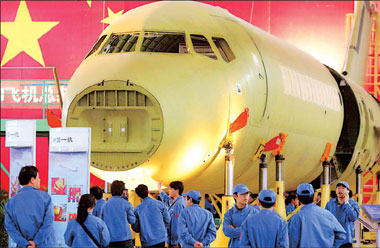Homemade jet aims 60 pct market
(AP)Updated: 2007-04-06 15:48
SHANGHAI -- China's first home-built commercial jet is expected to grab up to 60 percent of the domestic market for mid-size regional airliners over the next 20 years, the company's president said Friday.
China recently announced plans to build a large commercial jet by 2020, but Zheng Qiang, president of AVIC I Commercial Aircraft Co., said the project was still under study and no information had been relayed to his company.
China will need about 900 mid-sized regional jets over the next two decades, the company estimates, as economic growth drives an expansion of air travel and airlines look for planes best tailored to feeder routes.
Sales of the mid-sized ARJ-21, which has a seating capacity of 78-85, could come at the expense of Canadian airplane maker Bombardier Inc. and Brazil's Embraer SA.
Zheng said the ARJ-21's operating costs were up to 15 percent lower than its competitors, and put its list price at about US$30 million (euro22 million) - several million dollars (euros) less than comparable aircraft made by Bombardier and Embraer.
The initial focus for the ARJ-21 will be on the domestic market, but Zheng said the company also expects to sell the planes in Africa, other parts of Asia, and South America.
Chinese airlines that have already ordered 71 of the planes were not compelled to do so by the government, he said.
"This is entirely down to our own marketing," Zheng said in an interview at the company's offices in downtown Shanghai.
The ARJ-21 is now under production with the first test flights planned for next year. Zheng said development costs totaled 6 billion yuan (US$776 million; euro580 million).
The plane's suburban Shanghai final assembly line initially will produce 15 units per year, rising to 50 per year by 2015, he said. The company will also open a service center in Shanghai later this year to provide training and maintenance for customers.
Test flights are a year behind schedule. Zheng said that was due to a push in 2005 to refine the plane's aerodynamics and overall weight.
"We think these problems are pretty normal in any brand new airplane venture," Zheng said.
A collection of 19 foreign companies are supplying components to the plane, including engines from General Electric, a flight control system from Honeywell, and avionics from Rockwell Collins.
|
||
|
||
|
|

